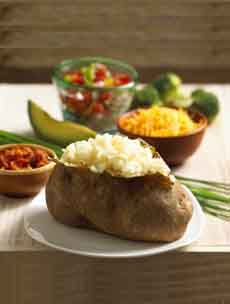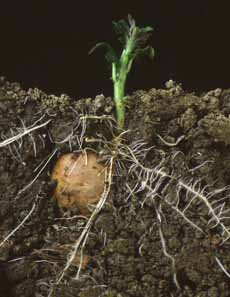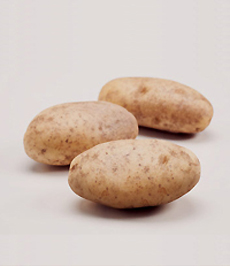
When you enjoy a baked Idaho potato, you’re probably not thinking of the many types of potato you might have had instead. Photo courtesy U.S. Potato Board.
|
MALLIKA RAO is an intern at THE NIBBLE. |
|
November 2010
Last Updated March 2020 |
 |
Potato History
How Many Potato Varieties Are There?
CAPSULE REPORT: In the first decade of the 21st century, the annual diet of an average human worldwide included 73 pounds of potatoes. Yet most of the potatoes consumed today come from only one species: the Solanum tuberosum. Within that species, there are many varieties, including russets, reds, whites, yellows, purples and fingerlings, all of which have varied colors, flavors and textures. Read on to learn about potato history and facts, or click here to skip to the Potato Glossary.
This is Page 1 of a seven-page article. Click on the black links below to view other pages. See our many other delicious food glossaries.
| Article Index: |
Potato Glossary: |
|
|
Overview
Potatoes are one of the most versatile and widely eaten foods worldwide. They are actually considered a stem tuber—a starch rather than a vegetable.
Popularly served as a side dish in the U.S.—baked, boiled, fried, hash-browned, mashed and roasted, potatoes can also be made into soups and salads, tossed into casseroles and distilled into vodka.
Because they can be cultivated anywhere (from subtropical to freezing climates) and grow well in poor soil, potatoes have gained popularity around the world. One can now find “traditional” potato dishes in every part of the globe.
Join us on a journey from the dawn of potatoes, high in the mountains of Peru, to the exciting varieties available in the market today.
|
|

What we call potatoes are the underground tuber of the potato plant. Photo © Adam Hart-Davis | H.G.org. |
Potato History
Wild potatoes are indigenous to the Andes Mountains in Peru. They were first domesticated more than 6,000 years ago. The Incas cultivated numerous species of potato. The name is said to originate from the Spanish patata, a combination of batata (sweet potato) and papa (a word for potato from the Inca Quechua language).
The Spanish conquered Peru around 1530 and brought potatoes back home to Spain—along with tomatoes, also native to Peru. News traveled fast (or what passed as “fast” in the centuries prior to the telegraph), and potatoes quickly reached the rest of Western Europe.
However, not everyone was enamored of the potato and the tomato. They were feared at first, accused of causing leprosy and being poisonous. They were classified as a relative of deadly nightshade, because both contain toxic compounds known as glycoalkaloids (though the levels in domestic potatoes and tomatoes fall far short of being harmful to people).
Slowly, more countries realized the power of the potato. It could grow in any climate. It thrived in Ireland, so much so that when hit by a potato blight, Phytophthora infestans, three years in a row, more than a million people died of starvation and disease.
Update: In 2013 a botanist discovered a wild Solanum jamesii potato plant in Utah, a cousin to the Solanum tuberosum of the Andes.
The jamesii species is native to North America and abundantly found in Arizona and New Mexico. Its existence in Utah was previously unknown to researchers.
The important news is that domestication in Utah is believed to predate domestication in the Andes: 7,000 to 10,000 years ago. Here’s more about it.
Potatoes were introduced to America in the 18th century. They were first planted in Idaho in 1836; the state now grows 25% of the nation’s potatoes.
Idahoan Luther Burbank developed the Russet Burbank potato in 1872, a more disease-resistant version of the Irish russet potato (there have been additional russet developments since. See some of them here.
And the rest is history.
Continue To Page 2: Potato Cultivation
Go To The Article Index Above
|
|

The disease-resistant Russet Burbank lead to the vast cultivation of what we call “Idaho potatoes. Photo courtesy GraceSeedGrowers.com.” |
|






